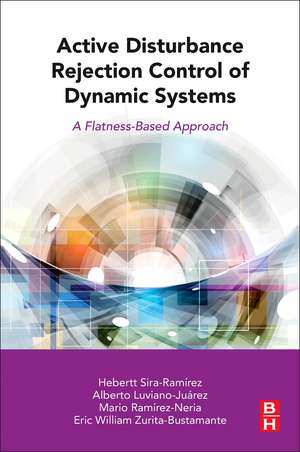Active Disturbance Rejection Control of Dynamic Systems: A Flatness Based Approach
Autor Hebertt Sira-Ramirez, Alberto Luviano-Juárez, Mario Ramírez-Neria, Eric William Zurita-Bustamanteen Limba Engleză Paperback – 11 mai 2017
This methodology differs from current robust feedback controllers characterized by either complex matrix manipulations, complex parameter adaptation schemes and, in other cases, induced high frequency noises through the classical chattering phenomenon.
The approach contains many of the cornerstones, or philosophical features, of Model Free Control and ADRC, while exploiting flatness and GPI control in an efficient manner for linear, nonlinear, mono-variable and multivariable systems, including those exhibiting inputs delays.
The book contains successful experimental laboratory case studies of diverse engineering problems, especially those relating to mechanical, electro-mechanical, robotics, mobile robotics and power electronics systems.
- Provides an alternative way to solve disturbance rejection problems and robust control problem beyond the existing approaches based on matrix algebra and state observers
- Generalizes the widely studied Extended State Observer to a class of observers called Generalized Proportional Integral Observers (GPI Observers)
- Contains successful experimental laboratory case studies
Preț: 647.77 lei
Preț vechi: 847.62 lei
-24% Nou
Puncte Express: 972
Preț estimativ în valută:
123.95€ • 132.55$ • 103.35£
123.95€ • 132.55$ • 103.35£
Carte tipărită la comandă
Livrare economică 11-25 aprilie
Preluare comenzi: 021 569.72.76
Specificații
ISBN-13: 9780128498682
ISBN-10: 0128498684
Pagini: 358
Dimensiuni: 152 x 229 mm
Editura: ELSEVIER SCIENCE
ISBN-10: 0128498684
Pagini: 358
Dimensiuni: 152 x 229 mm
Editura: ELSEVIER SCIENCE
Public țintă
Control engineering professors, Control engineering practitioners, Professionals in the field of Control of Mechatronics systems such as: Robotics, Mobile Robotics, Aerospace Robotics, Mechanical, Electromechanical Systems, Power Electronics Systems.Cuprins
1. Introduction
1.1 A Brief Historical Perspective on Active Disturbance Rejection Control
References
2. Generalities of ADRC
2.1 Introduction
2.2 Main Theoretical Issues
2.3 The Need for Flatness-Based ADRC Designs
2.4 Ultralocal Disturbance Models
References
3. Merging Flatness, GPI Observation and GPI Control with ADRC
3.1 Introduction
3.2 GPI Extended State Observer Design
3.3 An Observer-Based Approach to GPI Perturbation Rejection
3.4 The Buck Converter
3.5 Example: A Pendulum System
3.6 Two-Link Robot Manipulator
3.7 Nonholonomic Wheeled Car
3.8 Two-Mass Rectilinear Mechanism
3.9 Remarks
References
4. Extensions of ADRC
4.1 Introduction
4.2 Integral Reconstructors of MIMO Linear Systems
4.3 A Lyapunov Approach for a Class of Nonlinear Multivariable Systems
4.4 Combined Sliding-Mode–ADRC Controllers
4.5 ADRC and Sampled Systems: The Delta Operator Approach
4.6 Control of Time Delay Systems
4.7 Relations With Model-Free Control
4.8 Fractional-Order Systems
References
5. Case Studies
5.1 Introduction
5.2 A Two-Degree-of-Freedom Robotic Arm
5.3 An Omnidirectional Robot
5.4 A Single-Link Manipulator Driven by a Synchronous Motor
5.5 Nonlinear Pendulum System
5.6 The Thomson Ring
5.7 Trajectory Tracking Control of a Delta Robot
5.8 A Time-Delayed Flywheel System
5.9 Control of Robot Manipulators with Delayed Inputs
References
6. The Challenging Case of Underactuated Systems
6.1 Introduction
6.2 Controlling the Pendubot via Tangent Linearization
6.3 A Two-Mass Spring System with an Inverted Pendulum
6.4 Double Inverted Pendulum on a Cart
6.5 The Furuta Pendulum
6.6 The Ball-and-Beam System
6.7 Remarks
References
A. Differential Flatness
A.1 Definition of Flatness
A.2 Illustrative Examples
A.3 About the Advantages and Disadvantages of Flatness
A.4 Differential Flatness and Uncertainty
References
B. Generalized Proportional Integral Control
B.1 Definitions and Generalities
B.2 Generalized Proportional Integral Control and Classical Compensation Networks
B.3 An Illustrative Application Example
B.4 GPI Control for Discrete-Time Systems
B.5 A General Result for Multivariable Linear Systems
References
Index
1.1 A Brief Historical Perspective on Active Disturbance Rejection Control
References
2. Generalities of ADRC
2.1 Introduction
2.2 Main Theoretical Issues
2.3 The Need for Flatness-Based ADRC Designs
2.4 Ultralocal Disturbance Models
References
3. Merging Flatness, GPI Observation and GPI Control with ADRC
3.1 Introduction
3.2 GPI Extended State Observer Design
3.3 An Observer-Based Approach to GPI Perturbation Rejection
3.4 The Buck Converter
3.5 Example: A Pendulum System
3.6 Two-Link Robot Manipulator
3.7 Nonholonomic Wheeled Car
3.8 Two-Mass Rectilinear Mechanism
3.9 Remarks
References
4. Extensions of ADRC
4.1 Introduction
4.2 Integral Reconstructors of MIMO Linear Systems
4.3 A Lyapunov Approach for a Class of Nonlinear Multivariable Systems
4.4 Combined Sliding-Mode–ADRC Controllers
4.5 ADRC and Sampled Systems: The Delta Operator Approach
4.6 Control of Time Delay Systems
4.7 Relations With Model-Free Control
4.8 Fractional-Order Systems
References
5. Case Studies
5.1 Introduction
5.2 A Two-Degree-of-Freedom Robotic Arm
5.3 An Omnidirectional Robot
5.4 A Single-Link Manipulator Driven by a Synchronous Motor
5.5 Nonlinear Pendulum System
5.6 The Thomson Ring
5.7 Trajectory Tracking Control of a Delta Robot
5.8 A Time-Delayed Flywheel System
5.9 Control of Robot Manipulators with Delayed Inputs
References
6. The Challenging Case of Underactuated Systems
6.1 Introduction
6.2 Controlling the Pendubot via Tangent Linearization
6.3 A Two-Mass Spring System with an Inverted Pendulum
6.4 Double Inverted Pendulum on a Cart
6.5 The Furuta Pendulum
6.6 The Ball-and-Beam System
6.7 Remarks
References
A. Differential Flatness
A.1 Definition of Flatness
A.2 Illustrative Examples
A.3 About the Advantages and Disadvantages of Flatness
A.4 Differential Flatness and Uncertainty
References
B. Generalized Proportional Integral Control
B.1 Definitions and Generalities
B.2 Generalized Proportional Integral Control and Classical Compensation Networks
B.3 An Illustrative Application Example
B.4 GPI Control for Discrete-Time Systems
B.5 A General Result for Multivariable Linear Systems
References
Index
